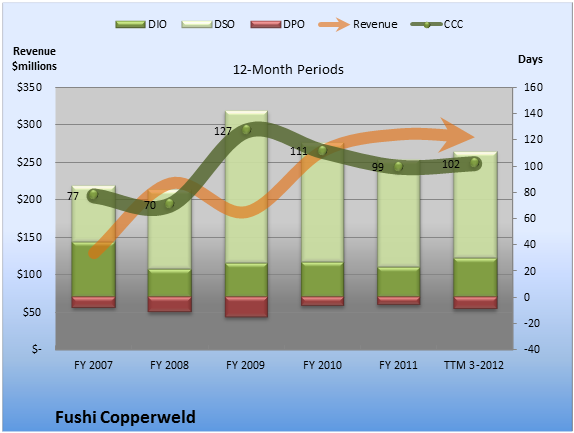How Fast Is the Cash at Fushi Copperweld?
It takes money to make money. Most investors know that, but with business media so focused on the "how much," very few investors bother to ask, "How fast?"
When judging a company's prospects, how quickly it turns cash outflows into cash inflows can be just as important as how much profit it's booking in the accounting fantasy world we call "earnings." This is one of the first metrics I check when I'm hunting for the market's best stocks. Today, we'll see how it applies to Fushi Copperweld (NAS: FSIN) .
Let's break this down
In this series, we measure how swiftly a company turns cash into goods or services and back into cash. We'll use a quick, relatively foolproof tool known as the cash conversion cycle, or CCC for short.
Why does the CCC matter? The less time it takes a firm to convert outgoing cash into incoming cash, the more powerful and flexible its profit engine is. The less money tied up in inventory and accounts receivable, the more available to grow the company, pay investors, or both.
To calculate the cash conversion cycle, add days inventory outstanding to days sales outstanding, then subtract days payable outstanding. Like golf, the lower your score here, the better. The CCC figure for Fushi Copperweld for the trailing 12 months is 102.0.
For younger, fast-growth companies, the CCC can give you valuable insight into the sustainability of that growth. A company that's taking longer to make cash may need to tap financing to keep its momentum. For older, mature companies, the CCC can tell you how well the company is managed. Firms that begin to lose control of the CCC may be losing their clout with their suppliers (who might be demanding stricter payment terms) and customers (who might be demanding more generous terms). This can sometimes be an important signal of future distress -- one most investors are likely to miss.
In this series, I'm most interested in comparing a company's CCC to its prior performance. Here's where I believe all investors need to become trend-watchers. Sure, there may be legitimate reasons for an increase in the CCC, but all things being equal, I want to see this number stay steady or move downward over time.

Source: S&P Capital IQ. Dollar amounts in millions. FY = fiscal year. TTM = trailing 12 months.
Because of the seasonality in some businesses, the CCC for the TTM period may not be strictly comparable to the fiscal-year periods shown in the chart. Even the steadiest-looking businesses on an annual basis will experience some quarterly fluctuations in the CCC. To get an understanding of the usual ebb and flow at Fushi Copperweld, consult the quarterly-period chart below.

Source: S&P Capital IQ. Dollar amounts in millions. FQ = fiscal quarter.
On a 12-month basis, the trend at Fushi Copperweld looks less than great. At 102.0 days, it is 4.9 days worse than the five-year average of 97. days. The biggest contributor to that degradation was DSO, which worsened 2.9 days when compared to the five-year average.
Considering the numbers on a quarterly basis, the CCC trend at Fushi Copperweld looks good. At 110.6 days, it is little changed from the average of the past eight quarters. With quarterly CCC doing better than average and the latest 12-month CCC coming in worse, Fushi Copperweld gets a mixed review in this cash-conversion checkup.
Though the CCC can take a little work to calculate, it's definitely worth watching every quarter. You'll be better informed about potential problems, and you'll improve your odds of finding the underappreciated home run stocks that provide the market's best returns.
Add Fushi Copperweld to My Watchlist.
At the time thisarticle was published Seth Jayson had no position in any company mentioned here at the time of publication. You can view his stock holdings here. He is co-advisor ofMotley Fool Hidden Gems, which provides new small-cap ideas every month, backed by a real-money portfolio. Try any of our Foolish newsletter services free for 30 days. We Fools may not all hold the same opinions, but we all believe that considering a diverse range of insights makes us better investors. The Motley Fool has a disclosure policy.
Copyright © 1995 - 2012 The Motley Fool, LLC. All rights reserved. The Motley Fool has a disclosure policy.

